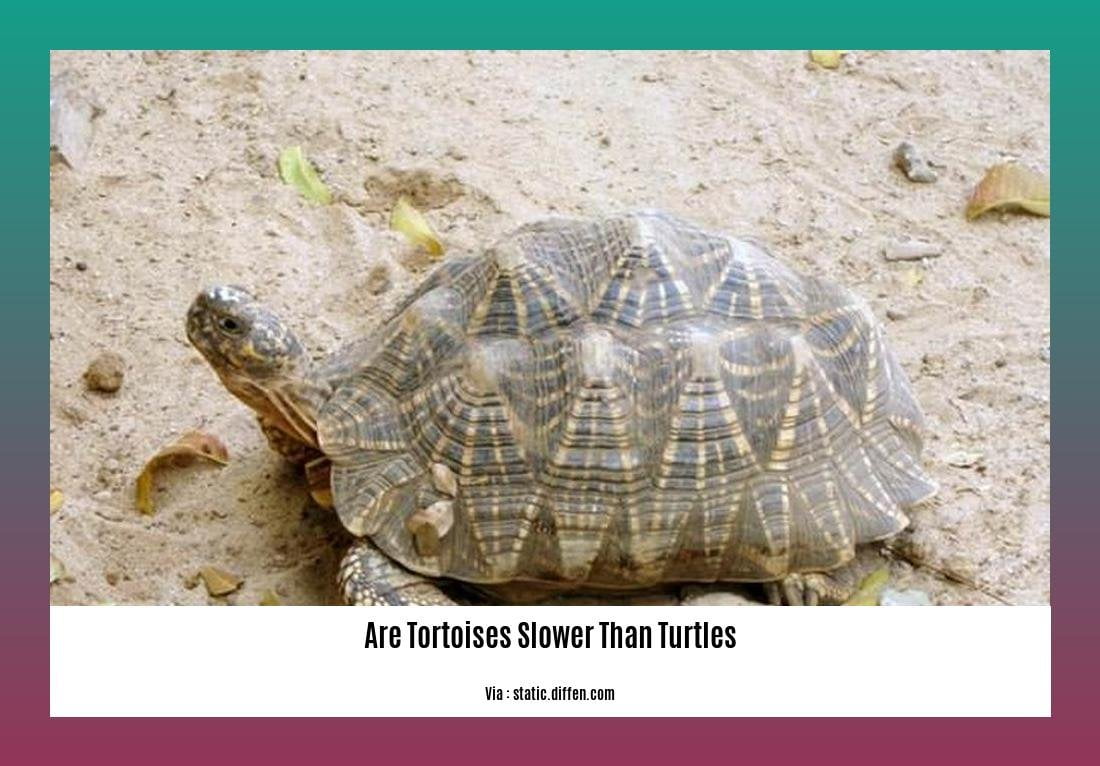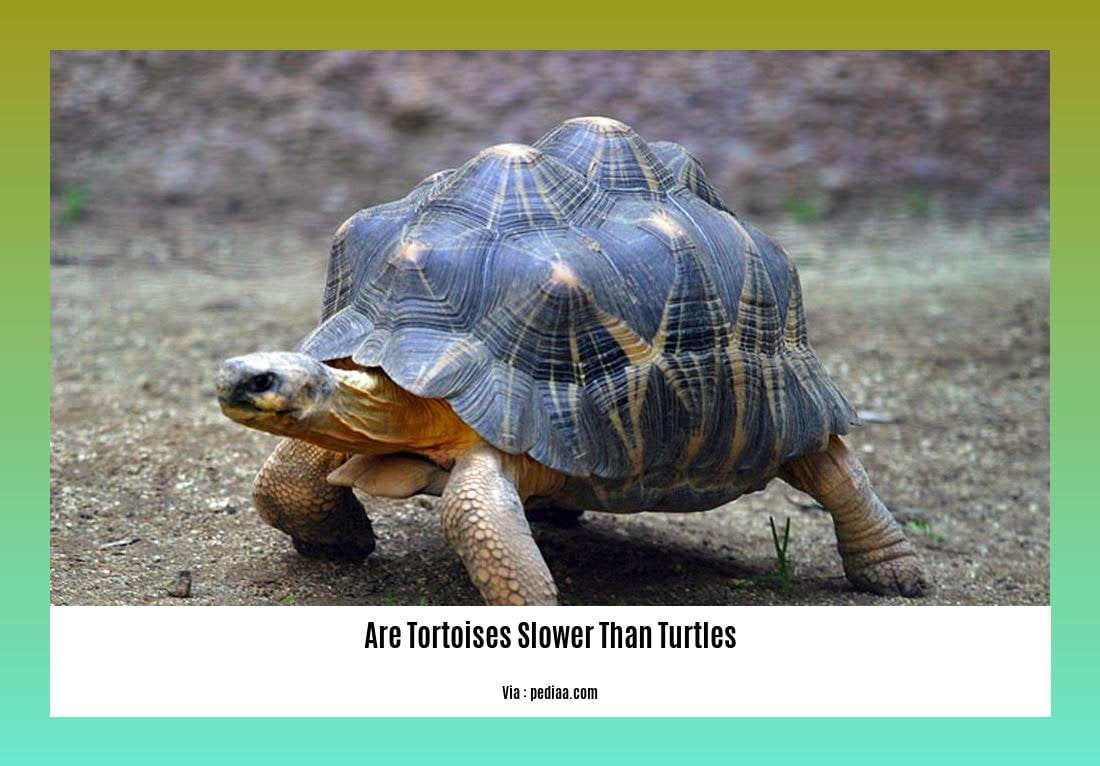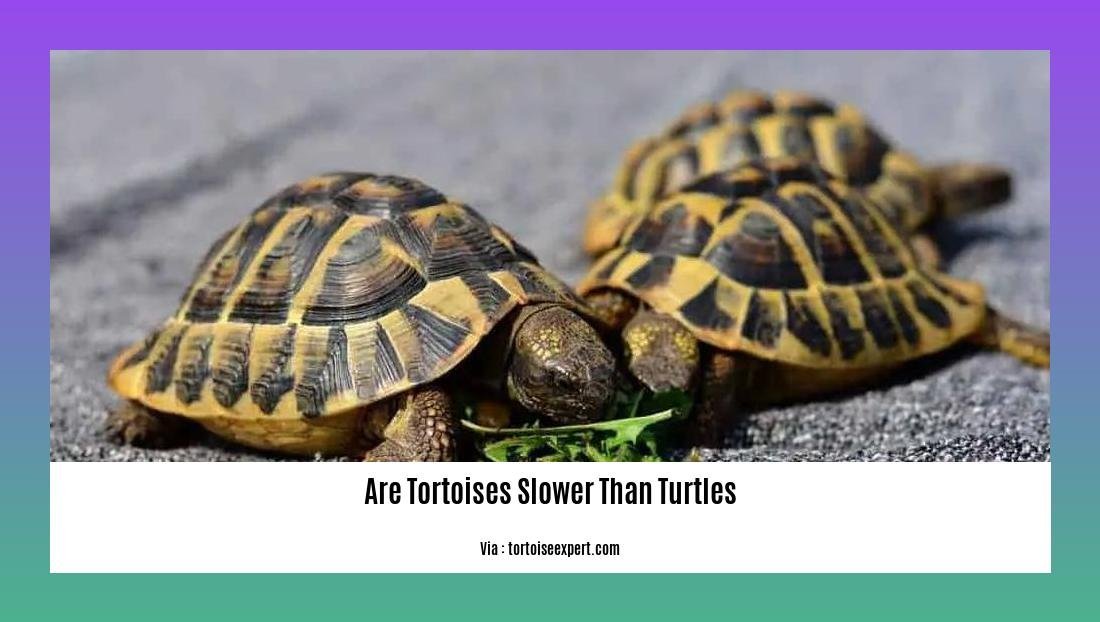Exploring the Speed Difference: Are Tortoises Slower than Turtles? If you’ve ever observed these majestic creatures, you may have wondered about their contrasting speeds. While both tortoises and turtles belong to the reptile family, the question remains: are tortoises truly slower than turtles? In this article, we dive into the intriguing world of tortoise speed, investigating the factors that contribute to their apparent sluggishness compared to their aquatic counterparts. Join us on this exploration as we unravel the truth behind this fascinating phenomenon.
Key Takeaways:
- Turtles are generally faster than tortoises, with average speeds of 10 to 12 mph in water and 3 to 4 mph on land.
- Some tortoise species can compete with turtles in terms of speed.
- Metabolism plays a role in determining an animal’s speed, with faster metabolisms generally correlating to faster movement.
- The size of turtles and tortoises can vary depending on the species.
- The Turtle Hub and A-Z Animals provide further information on the differences between turtles and tortoises, including their speed.
- Factors such as physique and metabolism contribute to the variations in speed within both turtles and tortoises.
- Studying the differences between turtles and tortoises can provide a better understanding of their contrasting speeds.
Are Tortoises Slower Than Turtles?

Turtles and tortoises, two distinct reptiles that fall under the Chelonia order, share some similarities but also have notable differences in terms of speed. While turtles generally exhibit faster movement compared to tortoises, there are exceptions to this generalization.
The speed of turtles in water ranges from 10 to 12 mph, but on land, their speed decreases to 3 to 4 mph. It’s important to note that speed can vary among turtle species. On the other hand, tortoises tend to be slower than turtles overall. However, certain tortoise species can still give turtles a run for their money in terms of speed.
Metabolism plays a pivotal role in determining the speed of animals, including turtles and tortoises. Scientific research indicates that metabolism has an impact on an animal’s movement. Generally, creatures with faster metabolisms tend to exhibit swifter motion.
Interestingly, the question of whether tortoises or turtles are bigger is a subject of controversy, as it heavily depends on the specific species. Both turtles and tortoises can vary in size, so it’s essential to consider this variability when comparing their speed.
To gain a deeper understanding of the differences between turtles and tortoises, numerous articles and sources are available for reference. The Turtle Hub offers comprehensive information on the dissimilarities between these reptiles, including their respective speeds. Additionally, A-Z Animals provides an informative article titled “Tortoise vs Turtle: 10 Biggest Differences Explained,” which further delves into the distinctions between these fascinating creatures.
In conclusion, while turtles generally exhibit greater speed than tortoises, it’s important to recognize the variations among different species within each group. Factors such as physique, including size and body structure, as well as metabolism, contribute to the differences in speed observed in these reptiles. By exploring the contrasts between turtles and tortoises, we can gain a clearer understanding of their relative speeds and the fascinating dynamics of the animal kingdom.
Sources:
The Turtle Hub. (n.d.). Are Tortoises Slower Than Turtles? Retrieved from
A-Z Animals. (n.d.). Tortoise vs Turtle: 10 Biggest Differences Explained. Retrieved from
Are turtles bad luck? Are turtles good pets for beginners? Find out more about these intriguing creatures and their impact on your life in our articles on bad luck and pet ownership. Dive into the fascinating world of turtles and discover the truth behind these common beliefs.
Why Are Tortoises Slow

Tortoises are fascinating creatures known for their slow pace. In contrast to their aquatic counterparts, turtles, tortoises have evolved to have a slower speed. But have you ever wondered why? Let’s dive into the factors that contribute to the slow movement of tortoises.
Anatomy and Physiology
One of the main reasons why tortoises are slow is due to their unique anatomy and physiology. Tortoises have a wide and low body shape, with their feet positioned far apart. This anatomical structure makes it challenging for them to move quickly, as their wide bodies create drag while their feet struggle to gain traction.
Additionally, the feet of tortoises are round, further hampering their ability to gain speed. Unlike the flippers of turtles, which are streamlined for swimming, tortoises’ round feet are better adapted for walking on solid ground. This design makes it difficult for them to achieve any significant speed.
Metabolism and Energy Conservation
Tortoise metabolism also plays a role in their slower movement. These reptiles have a slow metabolic rate, meaning they burn energy at a smaller rate compared to other animals. This slower metabolism results in reduced energy available for movement, contributing to their overall slow pace.
Interestingly, the slow movement of tortoises has a practical purpose. Their sluggishness allows them to conserve energy, which is particularly beneficial for a sedentary lifestyle. By moving slowly, tortoises can go for extended periods without needing to find food or water, making them well-suited for survival in environments with limited resources.
Inability to Swim
Another factor that contributes to the slow movement of tortoises is their inability to swim. Unlike turtles, tortoises lack specialized adaptations for swimming. They do not have webbed feet or streamlined bodies, which are essential for efficient movement in water.
This limitation significantly affects their mobility, as tortoises cannot stay afloat, let alone gain speed, in water. It is important to note that while turtles are generally faster in water, tortoises are adapted for a terrestrial lifestyle, where their slower pace is sufficient for their needs.
The Need for Protection
Although tortoises may be slower, they have specific adaptations that aid in their survival. One notable adaptation is their sturdy shells, which provide protection from predators. The shells compensate for their lack of speed by serving as a robust defense mechanism. This defense mechanism has allowed tortoises to thrive despite their slower movement.
Key Takeaways:
- Tortoises are slow due to a combination of factors, including their anatomical structure, round feet, slow metabolism, and inability to swim.
- Their wide body shape and round feet make it challenging for them to move quickly.
- Tortoises have a slower metabolic rate, resulting in reduced energy available for movement.
- Their inability to swim limits their mobility in water.
- The slow movement of tortoises allows them to conserve energy and adapt to a sedentary lifestyle.
- Tortoises make up for their slow speed with their sturdy shells, which offer protection from predators.
Sources:
- Tortoise Knowledge. (n.d.). Why Are Tortoises So Slow?
- Tortoise Website. (n.d.). Why do tortoises move slowly?
Are Tortoises Slower Than Turtles Compared To
When it comes to speed, turtles and tortoises have distinct differences. While turtles are generally more agile and can move faster in water, tortoises are slower on land but have unique adaptations for climbing and digging. In this article, we will explore the speed variations between turtles and tortoises and the factors that contribute to their different speeds.
The Fastest Turtle on Land
The fastest turtle on land is the softshell turtle, which can reach a remarkable speed of 3 mph or approximately 1.34 meters per second. This particular turtle species boasts webbed feet or flippers that are specifically designed for efficient movement in water, giving them an advantage in terms of speed when swimming.
The Speed of Tortoises
In comparison to turtles, tortoises are significantly slower on land. The fastest recorded speed for a tortoise is 0.28 meters per second or approximately 0.62 mph. This reduced speed can be attributed to the tortoise’s sturdy legs and heavier shells, which make it more challenging for them to move quickly. Tortoises are better adapted for climbing and digging rather than swift movement.
Adaptations for Speed
The differing speeds of turtles and tortoises can be attributed to their distinct physical adaptations. Turtles have flippers or webbed feet that are designed for swimming, allowing them to move rapidly in water. On the other hand, tortoises have limbs with scales and claws that are better suited for walking on land. While turtles have streamlined body shapes and flippers, tortoises have sturdy legs that enable them to navigate rough terrain more effectively.
Key Takeaways:
- Turtles are generally faster than tortoises.
- The fastest turtle on land can reach a remarkable speed of 3 mph.
- Tortoises are slower on land due to their sturdy legs and heavier shells.
- Turtles have flippers or webbed feet for swimming, while tortoises have sturdy legs for walking on land.
Sources:
1. Are Turtles Faster Than Tortoises?
2. What’s the Difference Between a Turtle and a Tortoise?
FAQ
Q1: Are tortoises slower than turtles in general?
A1: Yes, tortoises are generally slower than turtles. While turtles can move faster in water and on land, tortoises have a slower pace due to their sturdy legs and heavier shells.
Q2: Why are tortoises slower than turtles?
A2: Tortoises are slower than turtles due to several factors. Their wider and rounder feet, as well as their anatomical structure, make it difficult for them to move quickly. Additionally, tortoises have a slower metabolism, which affects their speed.
Q3: Can tortoises swim like turtles?
A3: No, tortoises cannot swim like turtles. Unlike turtles, tortoises lack the ability to stay afloat in water and therefore cannot gain speed through swimming.
Q4: Do all turtles and tortoises have the same speed?
A4: No, the speed of turtles and tortoises can vary depending on the species. Different turtle and tortoise species have different physical adaptations and characteristics that can affect their speed.
Q5: Are there any tortoise species that are faster than turtles?
A5: While turtles are generally faster than tortoises, there are some tortoise species that can provide competition to turtles in terms of speed. However, in general, turtles are known for their swiftness compared to tortoises.
- Star Ring Trends: Etsy vs Amazon - March 28, 2025
- Boost Pollinator Habitats: Baby Blue Eyes Sustainable Farming Guide - March 28, 2025
- Protect Big Black Bears: Effective Conservation Strategies - March 28, 2025
















